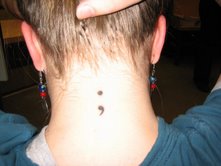
The other day I was talking to a friend about the standards of journalism in various publciations. “It was awful,” she said, “I was reading an article from [a local publication] and noticed several grammatical errors! I wrote the editors an email about how unimpressed I was.”
“Oh that’s awful!” I answered. I have always considered myself a grammar enthusiast.
“The author of the article didn’t use a semicolon before however!”
“What?” I asked. I blushed. Somehow the rules around semicolons have always elluded me. Give me commas and apostrophes any day, but somehow my teachers never satisfactorally explained the semicolon.
Thus, I went home and researched it, as to not be “out-grammared” by my friend.
I present to you… A brief lesson on just how cool the semicolon can be, created by The Oatmeal (Matthew Inman). The Oatmeal produces various images and comics that humourously educate readers about useful topics (such as the top ten words you need to stop misspelling) or silly themes (such as how to pet a kitty).
If you like the grammar graphics the Oatmeal features, and would like a poster version for yourself, you can always order one for a reasonable price. I find this a good feature, as I think many classrooms would benefit from having posters like this up on the bulletin boards. (There’s even a discount on the “grammar pack” of posters!)
Semicolons are useful for the following cases: English, particularly English essays; grammatically correct journal entries and shopping lists; making your writing look more impressive; and in blog posts about semicolons.
Good luck!
(P.S. – Did you notice my colon? For a less exciting guide on those, click here.)









